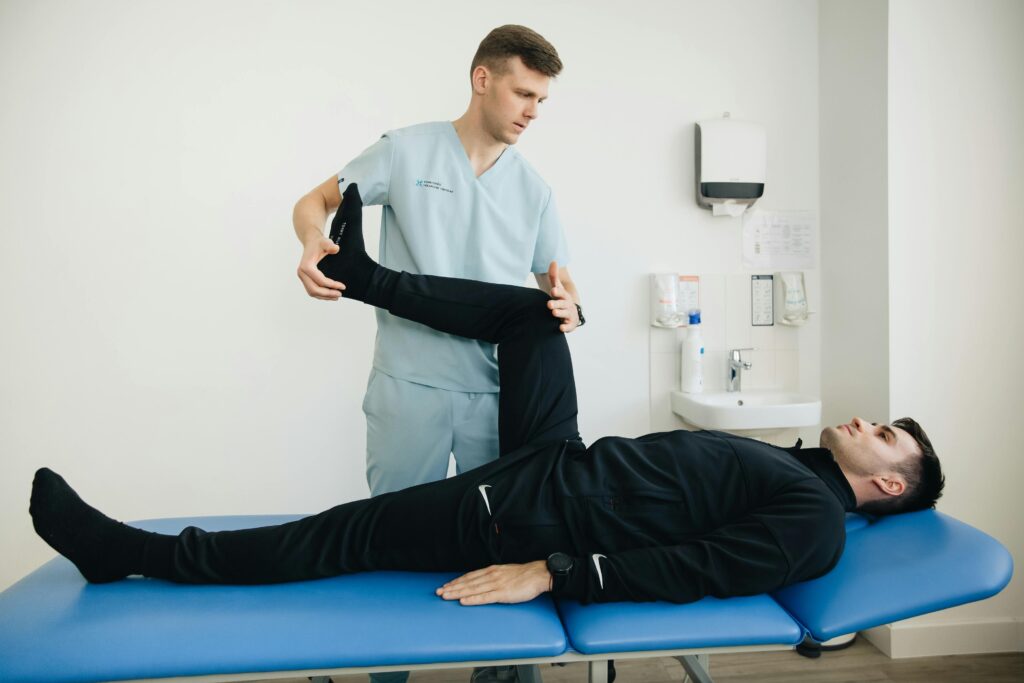Table of Contents
- Understanding the Consequences of Poor Posture
- Step 1: Assess Before You Address
- Step 2: Prioritize Core Function—Not Just Core Strength
- Step 3: Strengthen Posterior Chain Muscles
- Step 4: Incorporate Mobility and Flexibility Work
- Step 5: Integrate Posture Into Functional Movement
- Step 6: Use Daily Habits as Postural Practice
- Step 7: Leverage Technology for Posture Feedback
- Step 8: Be Aware of Psychological and Lifestyle Influences
- A Sample 3-Day Posture-Focused Training Split
- Final Thoughts: Posture Is a Lifelong Project
- About the Author
- References
In today’s digital age, poor posture has become a silent epidemic—worsened by sedentary lifestyles, desk jobs, and inadequate exercise habits. As a medical doctor with experience in both clinical care and industrial ergonomics, I’ve witnessed the profound effects that poor posture has on musculoskeletal health and overall well-being.
For fitness professionals, understanding the medical and biomechanical underpinnings of posture isn’t just a bonus—it’s essential. Personal trainers are often the first line of defense in preventing posture-related dysfunctions. With a proactive approach, you can help clients not only correct existing imbalances but also build lifelong habits that support spinal alignment and injury prevention.
In this article, we’ll explore practical, research-based strategies for personal trainers to help clients improve postural health through targeted exercise, education, and lifestyle changes.
Understanding the Consequences of Poor Posture
Postural misalignments aren’t just an aesthetic issue—they often manifest as:
- Chronic back and neck pain
- Shoulder impingement or instability
- Decreased core strength and balance
- Reduced respiratory function
- Nerve compression syndromes (e.g., sciatica)
A 2024 study published in Computers found that prolonged sitting and poor posture were strongly associated with the development of lower back pain, highlighting the musculoskeletal risks of sedentary lifestyles and static seated positions¹.
As a fitness professional, your programs can actively counteract these negative effects through evidence-based corrective strategies.
Step 1: Assess Before You Address
Posture correction begins with awareness. Encourage clients to understand their body’s baseline posture by evaluating common indicators such as:
- Forward head posture
- Rounded shoulders
- Anterior pelvic tilt
- Uneven hips or shoulder heights
Simple tools like posture grids, movement screens (e.g., Functional Movement Screen), or even video analysis can help track progress and refine programming.
Step 2: Prioritize Core Function—Not Just Core Strength
Many associate “core training” with six-pack aesthetics. In reality, the core’s primary function is stability. It acts like a central brace to support spinal alignment during movement.
Recommended Exercises:
- Dead bugs: Engage the deep core while maintaining spinal neutrality.
- Bird dogs: Train anti-rotation and coordination.
- Pallof press: Builds anti-rotational endurance in real-world planes.
- Plank variations: Focus on maintaining form over extended periods.
Cue clients to avoid holding their breath—encourage diaphragmatic breathing for optimal intra-abdominal pressure.
Step 3: Strengthen Posterior Chain Muscles
A lot of us sit more than we should—and it shows. Sitting for long periods can cause the muscles in the front of our body (like the chest, thighs, and hips) to get tight and overworked. At the same time, the muscles in the back—our glutes, hamstrings, and lower back—get weaker from underuse.
This muscle imbalance often leads to common posture issues: slouching, rounded shoulders, and a forward-tilted pelvis. That’s not just bad for your posture—it can cause pain too.
A 2020 study found that correcting pelvic tilt can actually help improve shoulder alignment and muscle activation in the upper back2. It’s all connected!
Best exercises to balance things out:
- Romanian deadlifts
- Hip thrusts
- Face pulls
- Band rows
- Reverse lunges
And if you’re sitting all day, don’t forget to stretch your hip flexors too.
Step 4: Incorporate Mobility and Flexibility Work
Inflexibility in certain muscle groups can limit posture correction, even when strength improves2. Focus on releasing tight areas that commonly restrict alignment:
Key Muscle Groups to Stretch:
- Pectoralis minor & major: Use doorway stretches and foam rolling.
- Hip flexors: Stretch with lunging hip openers and PNF stretching.
- Thoracic spine: Mobilize with foam rollers and thoracic extensions.
- Calves and hamstrings: Address both for improved pelvic alignment.
Encourage active stretching during warm-ups and longer holds during cooldowns to enhance flexibility over time.
Step 5: Integrate Posture Into Functional Movement
Integrating posture into everyday movements, especially during compound exercises, is crucial for long-term postural improvement. A 2023 study by Takahira et al. found that combining muscle training with posture learning exercises led to significant improvements in overall posture alignment. However, these improvements diminished after a week without continued practice, highlighting the importance of consistent integration of posture-focused exercises into daily routines3.
Practical Tips:
- During squats and deadlifts: Focus on maintaining a neutral spine and proper shoulder blade positioning.
- Controlled breathing: Teach diaphragmatic breathing to support spinal stability.
- Real-time cues: Use prompts like “Chest proud,” “Ribs down,” and “Glutes engaged.”
- Cardio considerations: Remind clients to avoid collapsing their spine or over-rotating shoulders.
By consistently applying these strategies, clients can develop better postural habits that extend beyond isolated exercises.
Step 6: Use Daily Habits as Postural Practice
A huge part of posture improvement happens outside the gym. As a trainer, you can empower clients by helping them embed movement literacy into their daily lives.
Recommendations:
- Encourage standing desks or desk breaks every 45 minutes.
- Suggest mobility flows in the morning or before bed.
- Teach ergonomic lifting for groceries, children, or home tasks.
Small, frequent corrections can make a larger impact than occasional perfect gym sessions.
Step 7: Leverage Technology for Posture Feedback
Wearable posture trainers, smart mirrors, or motion-tracking apps can provide real-time feedback and gamify posture correction. While these tools are optional, they can boost compliance and motivation.
Apps like PostureZone and wearables like Upright GO provide haptic feedback when slouching is detected, reinforcing good habits.
Step 8: Be Aware of Psychological and Lifestyle Influences
Posture reflects more than just physical alignment; it mirrors our emotional state. Confidence, stress, and fatigue can all influence how we hold ourselves. Research shows individuals with chronic pain and depression tend to have poorer postural balance4.
Chronic stress can lead to increased neck/shoulder tension, impacting posture. Studies show upright posture enhances mood and reduces fatigue5.
A Holistic Approach to Posture:
- Sleep Quality: Poor sleep impairs muscle recovery and posture.
- Stress Levels: High stress results in tight trapezius and neck muscles.
- Mental Well-being: Mindfulness practices can promote postural awareness.
Simple interventions like diaphragmatic breathing and yoga can enhance both posture and mental clarity.
A Sample 3-Day Posture-Focused Training Split
Day 1 – Postural Strength (Posterior Focus)
- Deadlifts – 4×5
- Face Pulls – 3×12
- Hip Thrusts – 3×8
- Reverse Lunges – 3×10 per leg
- Bird Dogs – 3×12
Day 2 – Mobility & Core Stability
- T-Spine Openers – 2×10/side
- Wall Angels – 2×15
- Pallof Press – 3×10
- Plank with Shoulder Taps – 3×20
- Breathing Drill – 3×5 deep breaths with core engagement
Day 3 – Functional Movement Integration
- Goblet Squat – 3×10 (focus on depth and posture)
- Step-Ups – 3×12 per side
- Farmer’s Carries – 3×30 sec
- Cable Row – 3×12
- Standing Shoulder Retractions – 2×15
Final Thoughts: Posture Is a Lifelong Project
Postural health isn’t something that can be “fixed” in a few weeks. It’s a dynamic reflection of how we move, sit, stand, sleep, and lift every day. As fitness professionals, your ability to assess and guide clients through this journey can have lifelong benefits—not just physically, but emotionally and cognitively.
By incorporating medically sound principles into your programming, you’re helping clients unlock not just better posture, but a better quality of life.
About the Author

Dr. Antti Rintanen is a licensed medical doctor from Finland with an MSc in Industrial Engineering and Management. He is the founder of The Internet Doctor, where medical science meets practical wellness. His work bridges clinical knowledge and fitness expertise to promote a healthier, more resilient population.
References
- Markova et al. (2024), Computers, 13(9), 231. https://doi.org/10.3390/computers13090231
- Murta et al. (2020), Brazilian Journal of Physical Therapy, 24(2), 135–143. https://doi.org/10.1016/j.bjpt.2019.02.002
- Takahira et al. (2023), Healthcare, 11(9), 1287. https://doi.org/10.3390/healthcare11091287
- Mingorance et al. (2022), Journal of Clinical Medicine, 11(10), 2700. https://doi.org/10.3390/jcm11102700
- Peper et al. (2017), Biofeedback, 45(2), 36–41. https://doi.org/10.5298/1081-5937-45.2.01
